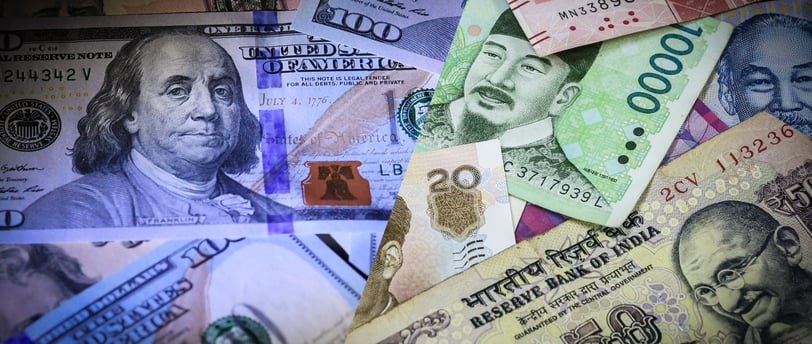Add your promotional text...
Asian Currencies Rebound as Dollar Weakens, But Trade War Fears Linger
Synopsis Asian currencies saw a modest recovery on Tuesday as the U.S. dollar eased after President Donald Trump delayed trade tariffs on Canada and Mexico. However, concerns remained as a 10% tariff on Chinese imports was still set to take effect. The offshore yuan fluctuated wildly, while the Japanese yen and other regional currencies made slight gains. With U.S. interest rates expected to stay higher for longer, markets remain on edge ahead of key nonfarm payroll data later this week.
FOREX
By Sonal Chauhan
2/4/20252 min read


Asian Currencies Recover, But Trade War Concerns Keep Markets on Edge
Regional Currencies Rebound as Dollar Weakens
Most Asian currencies saw a slight recovery on Tuesday, as the U.S. dollar pulled back following President Donald Trump’s decision to postpone tariffs on Canada and Mexico. The move provided temporary relief to risk-sensitive currencies in the region.
Despite the rebound, gains remained limited as markets braced for the impact of Trump’s 10% tariffs on Chinese imports, which were still set to take effect later in the day.
The dollar’s overnight weakness helped currencies such as the Japanese yen, South Korean won, and Australian dollar recover some of their recent losses. However, broader Asian markets remained cautious, particularly as concerns over prolonged high U.S. interest rates weighed on investor sentiment.
Performance of Major Asian Currencies
Japanese yen (USD/JPY): Rose 0.3% to 155.15 yen, after a sharp drop in overnight trade.
South Korean won (USD/KRW): Traded flat as cautious sentiment prevailed.
Australian dollar (AUD/USD): Dropped 0.2%, reflecting lingering trade concerns.
Singapore dollar (USD/SGD): Remained steady with minimal movement.
Indian rupee (USD/INR): Stayed near its record high of 87 rupees per U.S. dollar, highlighting concerns over capital outflows.
Chinese Yuan Volatile Ahead of Tariff Implementation
The Chinese yuan (USD/CNH offshore pair) experienced wild price swings, reflecting the market’s uncertainty over the impending U.S. tariffs on Chinese goods.
The offshore yuan briefly surged to a three-week high on Monday, reacting to Trump’s decision to delay tariffs on Canada and Mexico.
However, it quickly fell back as markets refocused on the imminent 10% tariff on Chinese imports, set to be enforced from 00:00 ET (05:00 GMT) on Tuesday.
Amid growing trade tensions, the White House announced that Trump is expected to speak with Chinese President Xi Jinping later this week, raising hopes for a diplomatic resolution that could prevent a full-scale trade war.
Still, investors remain cautious, as fears mount over a repeat of the U.S.-China trade war seen during Trump’s first term. While the tariff delay for Canada and Mexico was a positive development, it did little to alleviate broader market concerns about U.S. economic policy under Trump.
Dollar Declines on Tariff Relief, But Payroll Data in Focus
While the U.S. dollar weakened in response to the tariff postponement, losses were limited due to persistent concerns over inflation and interest rates.
The dollar index and dollar index futures both rose 0.2% in Asian trade, recovering slightly from overnight losses.
Recent strong PCE price index inflation data has reinforced the view that U.S. interest rates could remain higher for longer.
Federal Reserve officials have signaled a reluctance to cut rates aggressively, citing inflationary pressures and uncertainty over Trump’s trade policies.
Investors are now awaiting the U.S. nonfarm payrolls report due on Friday, which could influence the Fed’s future rate decisions. A strong jobs report could further diminish hopes for rate cuts, potentially strengthening the dollar and weighing on Asian currencies in the coming sessions.
Market Outlook: Uncertainty Looms Over Currencies and Trade
Despite the short-term relief from Trump’s tariff postponement on Canada and Mexico, the broader economic outlook remains fragile.
If Trump’s call with Xi Jinping leads to progress, Asian currencies could see a stronger rebound.
However, if trade tensions escalate further, the dollar could strengthen, leading to renewed pressure on emerging market currencies.
Interest rate concerns remain key, with the Federal Reserve’s stance on monetary policy likely to influence global currency movements in the weeks ahead.
With geopolitical risks and economic uncertainty still looming, investors are watching closely to see whether markets stabilize or brace for another round of volatility.
